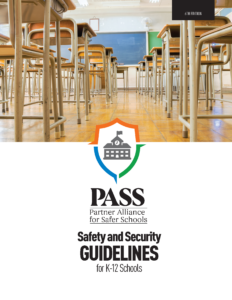PASS Guidelines Version 6 Now Available
Our world is constantly changing. That includes the safety and security obstacles we face each day and the technology available to help us overcome them. That’s why we make it a point to review and update our PASS Guidelines every two years.
These guidelines provide K-12 schools nationwide with a comprehensive list of best practices for securing school facilities. Additionally, the guidelines are reviewed and updated by subject matter experts across the country’s education, public safety, and security industries.
“Facility security measures are a critical part of protection, mitigation, and response and to keeping our schools safe,” said Jeremy Gulley, superintendent of Jay School Corporation in Portland, Ind. and a member of the PASS Board of Directors and Advisory Council. “The latest version of the PASS Safety and Security Guidelines reflects and addresses the most current threats facing K-12 schools and offers robust information and best practices for those of us in the education community on how we can better secure our schools.”
Safety and Security Guidelines
Our organization started in 2014 with the goal of bringing together experts to assist K-12 schools in developing a coordinated approach to effective security practices. As a result, the PASS Guidelines provide a multi-layer tiered approach to school safety and security. Schools can use the guidelines to enact effective and appropriate solutions to their safety and security strategies.
We break the guidelines into five physical layers of school facilities. Layers include district perimeter, property perimeter, parking lot perimeter, building perimeter, and classroom/interior perimeter. Then, we outline key safety and security components within those layers. Those components include policies and training, roles and training, architecture, communications, access control, video surveillance, and detection and alarms.
Guidelines Version 6 Update
This is our sixth revision to the PASS Guidelines. These updates strengthen our ability to help you develop a safe school plan, including crime prevention tactics, tips for staff training, and guidance on creating a crisis preparation plan. They will also advise you on how to get more involvement from key stakeholders such as community members, local law enforcement, parents, school board members, staff, and students.
New to the sixth-edition guidelines are the following features:
- More focused best practice recommendations to identify needed areas of improvement by separating the tier continuum practices that are already required by federal law or regulation or are already uniformly implemented throughout the U.S.
- Tiers redesignated for clarity, recommending that all schools and districts work toward Tier One measures regardless of location, budget, or risk profile. If Tier One measures are in place, all should work toward Tier Two. The need for Tier Three and Four measures depends on an assessment from the core security team.
- Enhancements to the classroom security section, which is a critical area for school safety. It’s simplified and updated with current terminology, illustrations, and recommendations consistent with modern, code-compliant door hardware and access control equipment.
- A new Enhanced Technologies section that details solutions under consideration by many schools and districts. These solutions show potential for significant improvements to school safety but may still need to be widely adopted. These include newer technologies in weapons detection, analytics, emergency communications, and biometrics.
Actionable Guidelines for Safety Planning
These guidelines provide stakeholders with specific actions that immediately improve security and offer vetted security practices specific to K-12 environments. They also provide objective and reliable information on available safety and security technology. Additionally, the guidelines offer options for addressing security needs and the ability to discern practical solutions from unnecessary products.
Furthermore, the PASS Safety and Security Guidelines are free to download, thanks to our volunteer contributors and PASS Partners. We urge everyone to set aside time to review the guidelines and consider how to implement them in their schools.
Contributors: PASS thanks our Advisory Council and Board of Directors for leading the review process for the Sixth Edition of the PASS Guidelines.
The Partner Alliance for Safer Schools (PASS) is a nonprofit 501(c)(3) bringing together expertise from the education, public safety, and industry communities to develop and support a coordinated approach to making effective and appropriate decisions with respect to safety and security investments. You can download the complete PASS Guidelines or check out our PASS Safety and Security Checklist for quick tips on how to get started. These resources—as well as whitepapers on various topics including barricade devices, lockdown drills, and more—are available at no cost.
Categories
- Access Control
- Classroom Door Locks
- Crime Prevention Through Environmental Design
- Cybersecurity
- Duress Alarm
- In the News
- Legislation
- Lockdown Drills
- New Technologies
- PASS Advisory Council
- PASS Board of Directors
- PASS Partners
- PASS Recommendations
- Preparedness
- Safe School Week
- Safety & Security Guidelines
- School Safety & Security
- Security Best Practices
- Video Surveillance

Ready to get the Guidelines?
The most comprehensive information available on best practices specifically for securing school facilities, vetted extensively by experts across the education, public safety and industry sectors.
